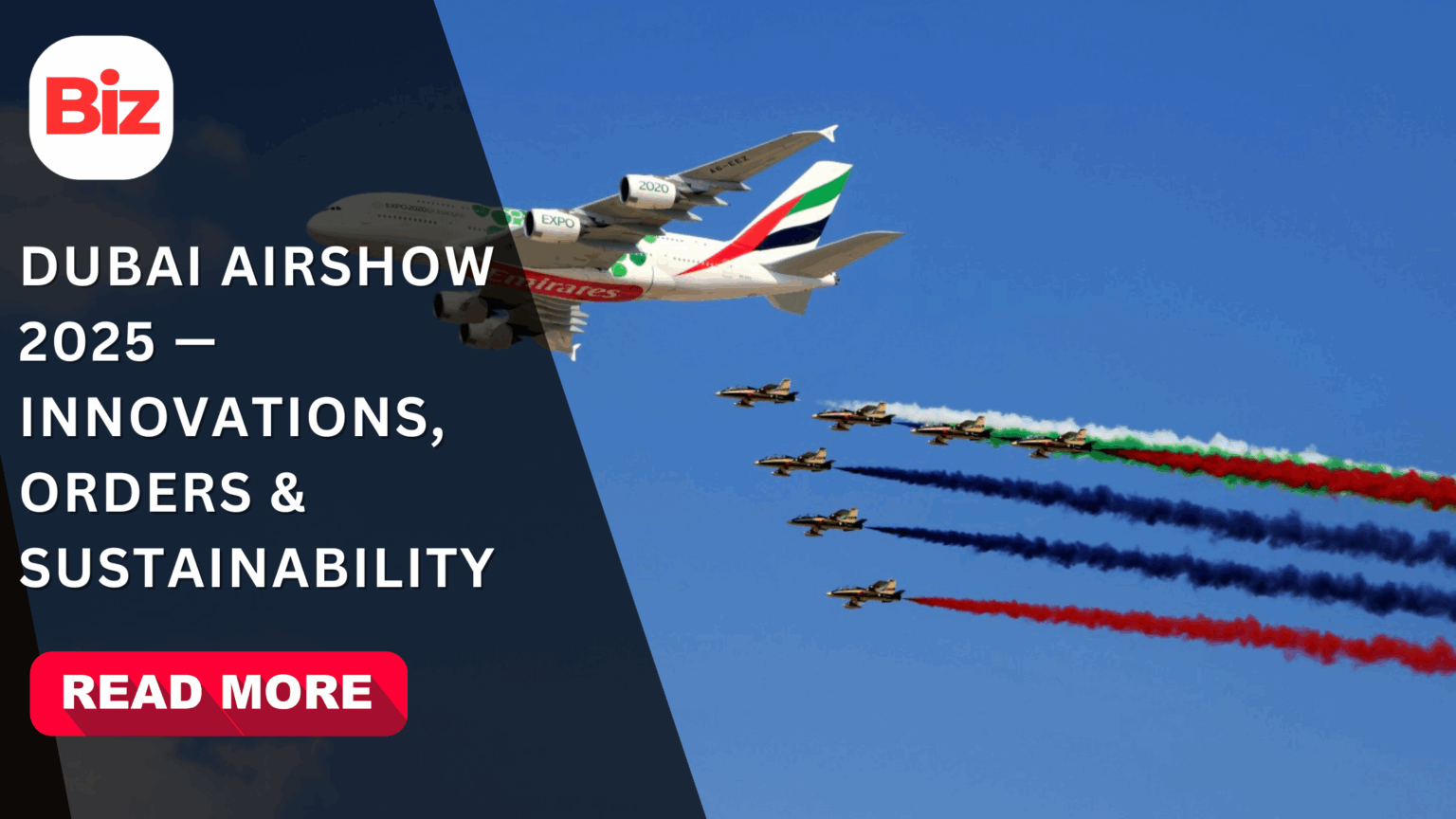- An International Stage to make Deals and Demonstrations.
- Sustainability goes to the Center Stage.
- Defence and Security: Strategic Dialogues.
- Startups and New Mobility Innovation Ecosystem.
- Airport Transformation and infrastructure.
- Human Element, Training and Talent.
- The Experience, Culture and Networking.
- Conclusion
The Dubai Airshow has been a stalwart of the world aerospace sector since time immemorial, and the 2025 show cemented its role as an active intersection of creativity, trade and aviation diplomacy. On the glossy backdrop of the Arabian Desert, the aviation industry heavy hitters, the government, airlines, defence, start-ups and aviation enthusiasts flocked to see the future of flight unfolded through advanced aircraft, innovative technologies and strategic alliances.
An International Stage to make Deals and Demonstrations.
A high stakes business environment is one of the major features of the Dubai Airshow. Big manufacturers, commercial and military, took advantage of the platform to launch new products, declare large fleet orders and demonstrate capabilities in live flight displays. The standstill and aerial demonstrations made me feel the physical aspect of the aviation industry, which is all about technical expertise as much as spectacle: modern aircraft making precision fly bus, advanced fighter planes demonstrating maneuverability, and futuristic electric vertical takeoff and landing, eVTOLs and autonomous demonstrators, which promise the next generation of mobility.
The business world was filled with making of deals. Middle Eastern, African and Asian airlines have also ordered and leased new planes which are indicative of a sustained hunger towards new and fuel efficient planes. The presence of leasing companies and financial institutions operating at the show also highlighted the robust demand of the fleet renewal and growth in new markets. Such deals not only indicate faith in demand recovery, but also prompt the industry to switch to more efficient and lower-emission platforms sooner.
Sustainability goes to the Center Stage.
The other theme was sustainability, which was evident during the event. With the ideas of sustainable aviation fuel (SAF) development and hybrid-electric propulsion, the industry used the Airshow to highlight practical resources to decarbonization. Significant OEMs and suppliers demonstrated minor advances in engine efficiency, lightweight materials and aerodynamics and made investments in long-term disruptive technologies, including hydrogen propulsion and advanced battery systems.
Conferences and panel discussions stressed the importance of collaboration throughout the supply chain: airlines, airports, producers of fuel, regulators, manufacturers must have a coordinated set of policies and investments needed to scale SAF production, build hydrogen infrastructure, and have certification pathways available to new propulsion systems. The point was simple: gradual efficiency improvement is crucial at this point in time, but revolutionary changes need coordinated industry and government measures.
Defence and Security: Strategic Dialogues.
The defense pavilion was a big attraction considering that Dubai is strategically located and has regional security interests. Cutting-edge military platforms, avionics, ISR systems and integrated defense solutions entertained delegations considering capability upgrades. The show offered not only a platform on which to make hardware purchases, but also on how-we-can-work-together on interoperability, regional security collaboration and partnerships in defense industry.
Live displays of unmanned systems and integrated air-defense concepts caused special concern. The growing overlap of commercial and defense aerospace technologies such as applying state-of-the-art data analytics, secure communications, autonomous systems was on exhibit, and how it is dual-use technologies that are defining the future of the activities of both the civic and military worlds.
Startups and New Mobility Innovation Ecosystem.
In addition to the well-known giants, innovation areas of the Airshow included startups and scale-ups that worked on disruptive solutions. eVTOL manufacturers and urban air mobility (UAM) platforms, autonomy software companies, and new ideas on air-traffic management were present to talk to investors and customers. These new entrants injected new vitality and prospective excitement, although many of them are years away before attaining commercial dimensions.
Regulatory frameworks, integration of airspace, reduction of noise and acceptance of them by the community were issues discussed by these innovators. The regulatorial message at the show was realistic in that safe, incremental integration of new mobility solutions will be preferred and pilots projects and demonstrators will lead to wider roll out.
Airport Transformation and infrastructure.
Much attention was also given to airports and ground system. As passenger traffic is set to increase over the next few decades, modernization of infrastructure, whether it is terminal capacity, airside operation, or digital baggage handling or biometrics, took up the bulk of several conference tracks. The Airshow reiterated how airports are becoming sophisticated intermodal mobility centers, which are forced to embrace technology-based efficiencies, yet not compromise on passenger experience.
Durability in harsh weather conditions, the ability to withstand extreme weather conditions, and the development of renewable energy on a pipeline basis were feasible issues to the airports in the region where weather factors and high degree of expansion pose unique challenges in the operations.
Human Element, Training and Talent.
Aviation is a people-focused industry, and the Airshow focused on workforce issues by providing specific training, retention and skills development sessions. As industry and academic institutions were deemed to be collaborating, an aging pilot and technician workforce in some parts of the industry and the urgent need to enhance new skill sets such as data science, remote operations, and battery technology expertise highlighted the necessity of collaboration between the industry and academic institutions. Efforts to open up and diversify aviation careers were highlighted such as apprenticeships, women-in-aviation initiatives, and STEM outreach to younger generation.
The Experience, Culture and Networking.
The Dubai Airshow is likewise an element of culture and socialization outside the halls and the runways. Deal-making and diplomacy were done with the help of manufacturers receptions, country pavilion, and bilateral meetings. In the eyes of fans, the show presented something beyond any other visual experience: the engine clatter, the view of a variant of a flagship airliner, or the close-up of an old plane reminded the air traveler of the romance of flight.
The event also helped consolidate the vision of Dubai as an international destination of meeting, the hospitality infrastructure and connectivity of the location also made it easy to get the guests of other parts of the globe to attend a high-impact week of concentration.
Some trends that are crystallized at the 2025 Dubai Airshow include:
- On-going fleet renewal of airlines concentrated on fuel efficiency and reduced operating costs.
- Rapid investment in SAF scale and early-stage adoption mechanisms.
- Hydrogen and hybrid-electric propulsion are still projected into the 2030s, but progress in that direction then.
- Development of dual use technologies between business aviation and military use.
- More regulatory clarity and pilot projects to combine Urban Air Mobility- UAM and eVTOL.
- A focus on human capital growth and part digitalization throughout the ecosystem.
Conclusion
The Dubai Airshow 2025 was not a trade fair, it was a strategic viewpoint of an industry in an inflection point. Although efficiency and fleet modernization is the focus of near-term commercial activity, what was evident in the talks and showcases of the show is that aviation is heavily investing in medium- and long-term transformational technologies. To the stakeholders in the government, commerce, and innovation, the Airshow was a focused venue to build partnerships, define policies, and fast track the move to a more sustainable, connected, and resilient aviation future.








